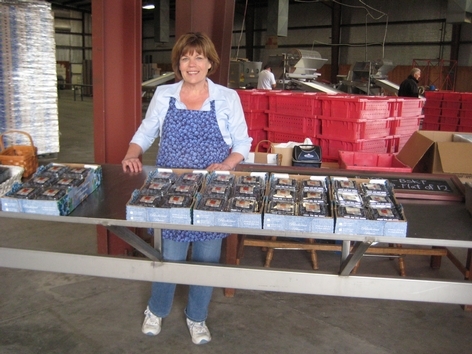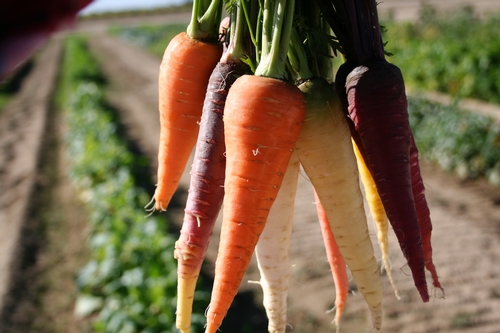Posts Tagged: Manuel Jimenez
Happiness is . . . California blueberries
Paul Willems, who co-owns Berry Lady Farms in Kingsburg with his wife Gayle, said berry season is a happy time for him and his family. He attributes their sunny disposition to all the blueberries in their diets.
“I feel better when I eat lots of blueberries,” Willems said. “They make you feel happier. I wish I had them all year long.”
Gayle Willems said the fruit may stimulate serotonin in the brain, providing a calming effect. But, she added, the good feelings may not be just the blueberries. "It makes us feel better anytime we eat healthy, right?"
The Willems may also be particularly happy during blueberry season because of the success of their 100-acre farm. The couple grows and sells 12 blueberry varieties over the season at a farm store, farmers markets and through conventional channels. Blueberries are expensive to establish and require a great deal of hand labor for harvest, but they are the second-most valuable crop per harvest acre, after cherries, according to the California Blueberry Association.
The California blueberry industry is growing at a healthy pace, and with 6,000 acres producing about 30 million pounds of the antioxidant-rich fruit, the industry’s volume has now surpassed Florida, said UC Cooperative Extension farm advisor Manuel Jimenez.
The milestone is significant, since the southern highbush blueberry cultivars grown in California originated in the Sunshine State. Southern highbush cultivars are well adapted to the California climate because they require fewer “chill hours” to produce fruit.
A leader in the development of the California industry, Jimenez has conducted blueberry observational trials – looking at yield and flavor characteristics – for more than a decade at the UC Kearney Agricultural Research and Extension Center in Parlier. In addition, the Kearney blueberry plantings have been the scene of ongoing studies on plant spacing, mulches and pruning, research that has helped farmers successfully establish the crop in the semi-arid San Joaquin Valley.
Jimenez will invite blueberry farmers and those considering entering the industry to Kearney this week to taste and compare 35 varieties of berries. Looking over the plots, Jimenez said it wouldn’t be difficult for a farmer to use information from the Kearney trials to select good-tasting berries that ripen sequentially for months, extending one farm's blueberry season from spring until mid-way through the summer.
“You could plant Snow Chaser, a very sweet, early variety, in hoop houses and start harvesting in the second or third week of April,” Jimenez said. “Next, Reveille could come into production. Southmoon is really late and then Centurion, a rabbit eye blueberry that’s small and sweet, would be ready in late July.”
For more information about the blueberry meeting this week at Kearney, see the flyer.

Gayle Willems at the Berry Lady blueberry stand, which sits inside the farm's packing house.
Vegetables, farmers, kids & adventures
Unusual vegetables and fruits get me every time. Rainbow carrots? Watermelon radishes? Party cauliflower? Romanesco?
Bright colors, quirky shapes and even creative names can stop me in my tracks at any farmers market. If I can't identify it, I feel compelled to buy some to take home and share.
The small-scale farmers who are likely to be selling these tempting curiosities are counting on customers like me (and maybe you too?). They often cannot compete on low prices alone, but small-scale farmers can succeed by differentiating their products from more widely available commodities through taste, appearance, harvest time or other qualities. Planting a new specialty crop can help a small-scale framers carve out a profitable niche in the marketplace.
For that reason, identifying and field-testing specialty crops is a focus of the UC Small Farm Program — and of a new project officially launched this week.
The UC Small Farm Program is a partner in the "Great Veggie Adventure," an effort launched by the makers of Hidden Valley Salad Dressings to identify a vegetable that few people have heard of, but that children might just love. The Small Farm Program is helping identify vegetable candidates that meet criteria highlighted by a survey of elementary school students' vegetable preferences.
Our farm advisors will be growing varieties of rainbow carrots, watermelon radish, party cauliflower and Romanesco in demonstration plots around the state. Though small farm advisors frequently test and demonstrate interesting new crops, this time they will be bringing kids behind the scenes, with blog posts and video updates from their fields.
Will these "new" vegetables snag the curious tastebuds of kids? We'll have to wait and see.
But I know some vegetables that I'll be keeping an eye out for at my farmers market...
Did you know?
- Aziz Baameur, UC Cooperative Extension farm advisor (also with the Small Farm Program) and Maria Giovanni, nutrition advisor, conducted field tests and tasting panels with a rainbow's array of carrots. Read more about it in UC Delivers.
- The Great Veggie Adventure is part of the "Love Your Veggies" program, now in its fifth consecutive year. Hidden Valley created the Love Your Veggies program in 2007 after a study by UC Cooperative Extension Butte County and the Expanded Food and Nutrition Education Program. Read about their study in this ANR News Blog post.
Video: Manuel Jimenez, UC Cooperative Extension farm advisor in Tulare County, introduces his work with the UC Small Farm Program — and the program's involvement in the "Great Veggies Adventure"


